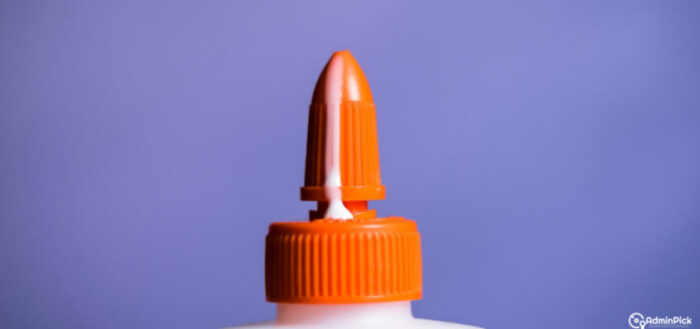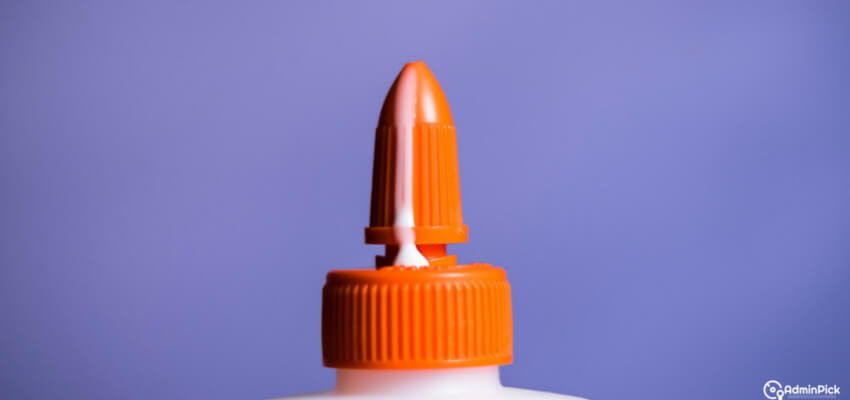There are many reasons why hot glue is not the best option for gluing together objects, but let’s just focus on one: it’s messy. Whether you’re using a hot glue gun or sticks that come in a tube, it can be difficult to get everything lined up and glued down properly without getting excess glue everywhere.
Hot glue also takes time to cool off before you can handle the object again, which means more waiting! In this blog post, we’ll talk about four alternatives to traditional hot glue that will help keep your crafting space clean and organized while still being able to create durable bonds between two surfaces.

Here Are The 9 Hot Glue Alternatives:
1. Super Glue
2. Gorilla Glue
3. Crazy Glue
4. Hot Melt Adhesive (HMA)
5. Contact Cement
6. Rubber Cement
7. Weldbond Liquid Plastic Welder (LPW)
8. Sticky tack
9. liquid nails or epoxy resin for metal, plastic, and wood projects
Super Glue
Superglue is a chemical compound that turns into a sticky liquid when it comes in contact with the surfaces you would like to bond together. When you apply pressure and hold them together for about 30 seconds, they will form an instant connection without clogging up your workspace or taking too long to dry!
This means more time finishing projects instead of waiting around for glue to cool down before handling items again. It’s also fast-acting which makes it ideal for repairs on clothing during fashion week as well since stitches can take hours to set properly but this adhesive dries in under two minutes so there’s less downtime and wasted fabric while making sure everything stays neat and tidy backstage at these events.
Gorilla Glue
Gorilla Glue is a really popular adhesive with lots of great qualities. A feature that makes it stand out from most other adhesives on the market today is its fast-acting formula, which means you can work quickly and get things done before they have time to set!
It also does not clog up your workspace or dry slowly as some other glues do; this may be because Gorilla glue doesn’t need any special application tools such as brushes or spatulas in order to apply correctly.
This particular quality has made it the go-to for many professionals who are constantly working on projects at high speeds where getting stuck waiting around for an extra step would only hinder their workflow overall.
If you want something straightforward, that can handle heavy-duty tasks and still be strong enough to hold objects together, the Gorilla glue is a great choice for you.
– Hot Glue
– Hot Glue Alternative
This particular quality has made it the go-to for many professionals who are constantly working on projects at high speeds where getting stuck waiting around for an extra step would only hinder their workflow overall. If you want something straightforward, that can handle heavy-duty tasks and still be strong enough to hold objects together, the Gorilla glue is a great choice for you. Â It also does not clog up your workspace or dry slowly as some other glues do this may be because Gorilla glue doesn’t need any special application tools.
Crazy Glue
The Crazy Glue is the perfect option for you if you are looking to use your glue in a pinch. Its adhesive power and fast-drying time will make this last-minute emergency repair much less of an inconvenience than it could have been without any glue at all, but there are some drawbacks as well.
The downside to using the Crazy Glue is that it can dry fairly quickly which leaves little room for error or adjustment when dealing with more delicate materials like paper mache cloths, fabric, or certain types of wood. You also won’t be able to reuse the cotton balls from this type of glue because they dissolve after being exposed to air, so prepare yourself accordingly by buying extra cotton each time before applying pressure on whatever needs gluing.
Hot Melt Adhesive (HMA)
Hot Melt Adhesive (HMA) is a type of glue that’s often used in the automotive industry as well as for woodworking and furniture making. It’s typically not used on surfaces like paper, fabric, or metal since it can cause damage to those types of materials over time when exposed to air because it dries fast.
Unlike liquid adhesives, this one comes with an applicator which makes applying hot melt much easier than other options listed here so I would recommend using this if you’re working with large projects where precision isn’t very important but quick drying times are needed.
The downside to HMA is that while it does dry quickly, mistakes made during application tend to be more permanent than they might have been if glues like Elmer’s were used.
Other viable alternatives to HMA can be found on the market which is more cost-effective and offers a variety of other benefits such as water resistance, chemical resistance, or heat stability. Here are some examples:
– Hot Melt Glue Sticks (from around $25)
– Weldbond Liquid Adhesive ($22 for 12 ounces)
– Super 77 Spray Adhesive ($11 for 16 fluid ounces)
– Gorilla Wood Glue ($27 for 11 oz.)
Contact Cement
Contact cement is a type of adhesive that works like glue but can be removed by applying water to the surface. This makes contact cement perfect for projects where mistakes are common or if you need to make adjustments later on in your project’s life cycle.
Some downsides to contact cement include:
– They have a limited shelf life, typically around one year from the manufacturing date (extend this time frame with refrigeration)
– Requires clean and dry surfaces before application; will not work as well when applied over other adhesives such as Elmer’s Glue Stick Adhesive ($19 per tube). Contact Cement won’t adhere directly to any smooth plastics or PVCs either.
– Takes 24 hours for contact cement to dry
Some materials that contact cement work well with include:
– Foam Board (comes in different thicknesses and can be cut into any size)
– Cardboard, paper, wood, or other adhesives which are not smooth plastics or PVCs. Tissue Paper ($18 for a pack of 500 sheets), Kraft Paper ($11 per roll), and sandpaper ($25 per jar) all come off very easily from these types of surfaces once the adhesive has dried. Contact Cement is also great for decorating fabrics such as quilts or drapes because it will permanently adhere without damaging fabric fibers.
Rubber Cement
Rubber Cement is a white adhesive that comes in a tube or as an aerosol spray. It’s great for gluing paper, fabric, and other porous materials together because it dries clear.
Rubber cement will not adhere well to any smooth plastics such as PVCs or polyethylene terephthalate (PET) plastic bottles so be sure to let the glue dry on one surface before applying it onto another.
Contact cement is better at adhering directly onto these types of surfaces than rubber cement.
– Can use contact cement instead if you’re planning on sticking your material into some kind of frame where you’ll need both sides to match up perfectly
– Clear drying time: 24 hours per application
– Price: $0.50
– Type: Adhesive
Weldbond Liquid Plastic Welder (LPW)
Weldbond is a liquid plastic welder that’s applied to two surfaces and then the adhesive re-solidifies into one solid piece. It’s great for gluing paper, fabric, and other porous materials together because it dries clear.
Contact cement will not adhere well to any smooth plastics such as PVCs or polyethylene terephthalate (PET) plastic bottles so be sure to let the glue dry on one surface before applying it onto another. Weldbond is better at adhering directly to these types of surfaces than contact cement is.
Clear drying time: 24 hours per application.
Price: $0.50
Type: Adhesive
Sticky tack
Sticky tack is a type of adhesive product that’s known for its ability to hold items lightly and yet securely in place, even with movement. This makes it perfect for crafts where you want your item to stay put while still being easily removable at any point: garlands, backing paper onto frames or shelves, sticking up posters, etc.. Clear drying time: 24 hours per application.
Price: $0.05 – 0.25
Type: Adhesive
Liquid Nails Or Epoxy Resin For Metal, Plastic, And Wood Projects
Liquid nails and epoxy resin are two of the most popular hot glue alternatives for metal, plastic, and wood projects. These types of adhesives can be used both to connect one material to another as well as seal up gaps in objects where a little bit may have been chipped off or torn away at some point. Clear drying time: 24 hours per application.
Price range: $0-$15
Type: Adhesive; Sealant (Epoxy Resin)
The next set of sentences will describe how liquid nails work with different surfaces like metal, plastic, or other materials that it is good for use on such as foam-backed carpeting. Take care when using this type of adhesive because you don’t want it.

